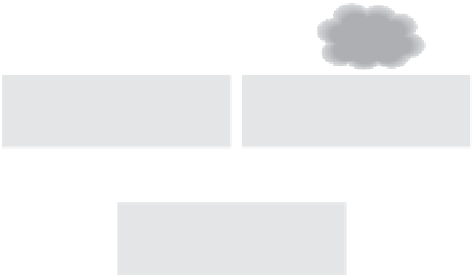Graphics Reference
In-Depth Information
(b)
(a)
Surface transmittance function
Volume transmittance function
(c)
Transmittance function
Figure 3.19
The net transmittance function (c) of a deep shadow map is the product of the surface
transmittance function (a), which steps through translucent surfaces, and the volume trans-
mittance function (b) of the participating media. (After [Lokovic and Veach 00].)
mittance function is the product of two different transmittance functions: the
sur-
face transmittance function
(
Figure 3.19(a)
)
, and the
volume transmittance func-
tion
(
Figure 3.19(b)
)
. The surface transmittance function ignores participating
media and tracks changes in the net transmission at surface points. It is there-
fore a step function: the value starts at 1 at the light source, then drops at each
surface intersection according to the opacity of the surface material. The volume
transmittance function is the same as the transmittance function for participating
media. The net transmittance function is stored as a series of sample points; the
function value is estimated between samples using an exponential interpolation.
The visibility function for a pixel in the deep shadow map is constructed by
sampling and averaging the transmittance functions over a set of sample rays cov-
ering the pixel. This is essentially the same process used in Monte Carlo ray
tracing and serves to antialias the resulting shadows. In addition, a variety of fil-
tering effects can be applied in computing the visibility functions. In particular, a
multiresolution prefiltering technique used for rendering at various levels of detail
known as
mipmapping
2
can be applied. Such filtering is particularly important for
moving images.
Separating the transmittance functions by surface and volume allows artists
to design the surface characteristics without concern for the participating media.
Because they are independently integrated, the deep shadow map can be rebuilt
for different media without resampling the object geometry. Pixar artists started
2
Mipmapping
is a technique developed by Lance Williams that stores a texture or other image in
a sequence of different sizes [Williams 83]. In a preprocess, the image is repeatedly downsampled
by a factor of two until it is reduced to a single pixel; all the downsampled images are stored in the
mipmap. A version of the image appropriate for any scale is then readily available at render time.



























































